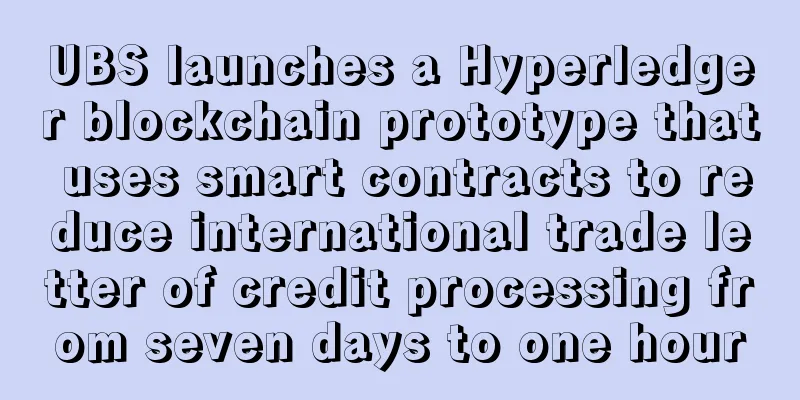UBS launches a Hyperledger blockchain prototype that uses smart contracts to reduce international trade letter of credit processing from seven days to one hour

|
Swiss bank UBS has launched a prototype of a project that aims to replicate the entire lifecycle of international trade transactions on Hyperledger’s Fabric blockchain. The project is a joint effort between UBS and IBM. The trade finance project is still in its early stages of development, but it can be said that this project is more ambitious than many other blockchain prototypes. The prototype is designed to be "holistic" in combination with payment transactions, integrating trade finance transactions, foreign exchange payments, etc. into a carefully crafted smart contract. According to Beat Bannwart, head of product and market development at UBS's transaction bank, the project involves all of UBS's experts in these areas. Bannwart said:
In large transactions, the buyer's bank can use letters of credit to mitigate the seller's perceived risk in the product transition process. But letters of credit can take up to seven days to process, during which time additional risk can accumulate, according to UBS. How complicated is the use of letters of credit? UBS said that a letter of credit weighs 500 grams and contains 36 documents. But by programming the process into a smart contract on Hyperledger, Bannwart said he expects to be able to reduce processing time from seven days to one hour. In addition to the letter of credit process application, UBS said in a video presentation at the Sibos conference held on Wednesday that the project will also include account opening processes. Bannwart said:
Financial technology startups bring rapid iterationUBS emphasized ease of use throughout the video presentation, with the focus on the project's goal of creating a user-friendly interface that would work non-stop. To take this design thinking forward, much of the work on the project was done during a two-day workshop at London-based financial technology accelerator Level 39. During the creation of the project, representatives from the IT department of UBS and employees of the IBM Competence Center completed the transition from the visualization stage to the product creation stage. Fabio Keller, an IBM account executive who led UBS's integrated accounts team, described the creation as "a group of exceptional people sitting around a table, locked in a room, thinking things out." According to Alex Batlin, senior innovation manager at UBS, the participants are all startups from the Level 39 accelerator, including cloud blockchain startup Credits and smart document startup Clause Match. Batlin said that although these startups have not yet signed any cooperation contracts with UBS, their participation is part of UBS's larger strategy. He said:
Time frame unknownReports of UBS’s blockchain work have percolated across the web over the last year, including that the bank was conducting multiple blockchain ‘trials’. As reported last month, a five-member consortium is working on a practical ‘settlement coin’ designed to help central banks embrace the functionality of blockchain, one of which is UBS. Furthermore, it is still unclear how long it will take to complete this international trade project. But Keller said one thing is clear. UBS plans to bring the prototype to consumers and end users in the hope of "validating" that the bank is "going in the right direction." |
<<: The second generation of the Internet is coming: blockchain distributed Internet
>>: Bitcoin brings needed peer-to-peer payment system to mesh networks
Recommend
Does a man with thick upper lip and thin lower lip have a serious mind?
Does a man with thick upper lip and thin lower li...
Palmistry for money leakage
I believe many people have heard of the term &quo...
What kind of man is a master of love?
What kind of man is a master of love? 1. A good m...
Is a woman with a mole behind her left ear lucky? What does a mole behind a woman's left ear mean?
Everyone says that people with moles behind their...
Jin Zizai's fortune-telling - Asking for the name in the ear
The ears represent name and fame, and are also th...
How to interpret a man's fierce personality
The irritable side of a person is actually quite ...
Analysis of the facial features of women who are relatively passive in relationships
In relationships, many people know that if they do...
What kind of face is successful in career
We all hope to achieve some success in our career...
What kind of people have the worst luck?
A person’s fortune can be seen from his face; so,...
What does a woman with a mole on her face indicate? What is her personality and fortune like?
In traditional physiognomy theory, a person's...
What mistakes are you most likely to make?
What mistakes are you most likely to make? People...
What is the fate of a woman with splayed eyebrows?
Classic fortune-telling: Detailed prediction of y...
Where do IoT and blockchain intersect?
In the next few years, the Internet of Things wil...
Let’s talk about: Sidechain, Drivechain and Rootstock two-way hook design
In a recent technical paper, we analyzed differen...
Changpeng Zhao and He Yi respond to Forbes' accusation that Binance US is a fraudulent operation: creating panic, nonsense
According to BlockBeats, on October 30, Forbes re...









